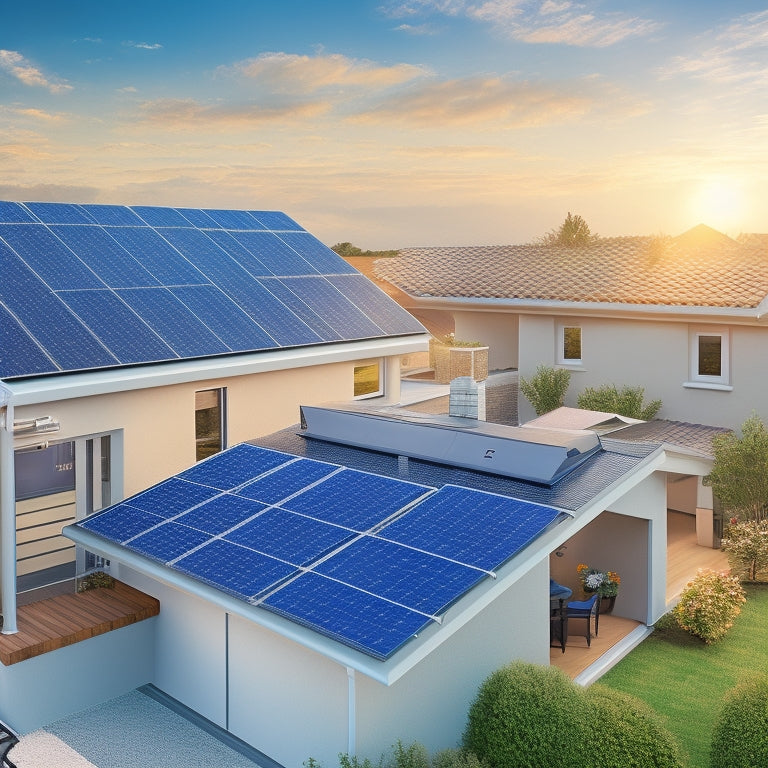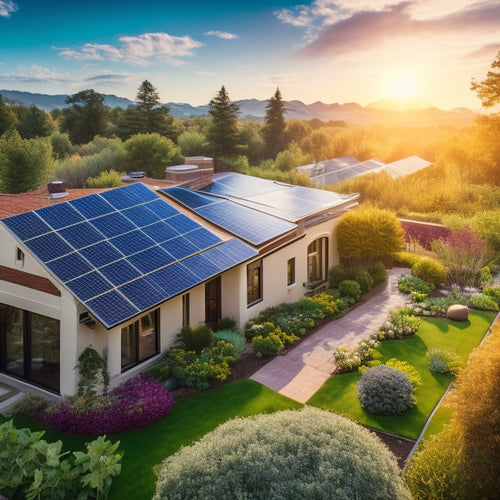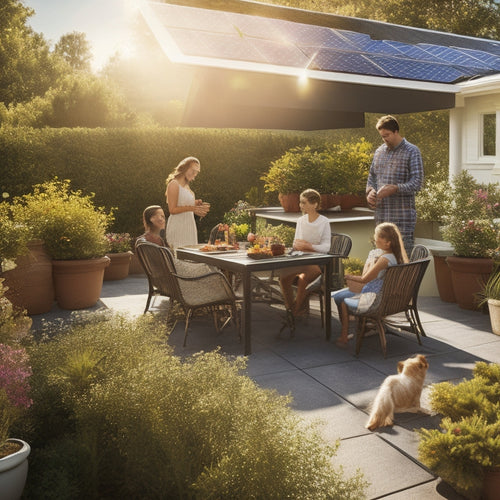
Required Residential Solar Equipment for Installation
Share
You'll need a range of equipment to install a residential solar system, including solar panels and mounting systems to capture sunlight, inverters and conversion equipment to convert DC power to usable AC power, charge controllers and monitoring systems to regulate energy output and track performance, electrical distribution and wiring to connect the system, grounding and earthing systems to guarantee safety, and safety and protection devices to prevent electrical shocks and faults. Each component plays a vital role in guaranteeing the system operates efficiently and safely, and understanding their functions is essential for a successful installation - there's more to investigate to get it right.
Key Takeaways
- Solar panels and mounting systems are essential for capturing sunlight and converting it into energy, with options including monocrystalline, polycrystalline, and thin-film panels.
- Inverters and conversion equipment are necessary to convert DC power from solar panels to usable AC power, with string inverters, microinverters, and power optimizers being popular options.
- Charge controllers and monitoring systems regulate solar power output for efficiency and safety, with features like overcharge protection, voltage regulation, and performance tracking.
- Electrical distribution and wiring components, including the main service panel, inverter wiring, and DC wiring, must be installed with safety and efficiency in mind to minimize energy losses.
- Grounding and earthing systems, safety devices, and protection devices are crucial for protecting against electrical shocks and faults, and ensuring compliance with local electrical codes and regulations.
Solar Panels and Mounting Systems
Throughout your residential solar equipment setup, solar panels and mounting systems play an essential role in capturing sunlight and converting it into electrical energy.
You'll need to choose the right solar panel type for your setup, considering factors like efficiency, durability, and cost. Monocrystalline, polycrystalline, and thin-film solar panels are popular options, each with their advantages and disadvantages.
When it comes to mounting systems, you'll need to decide on a mounting technique that suits your roof type and local building codes. Roof-mounted systems are the most common, but you may also consider ground-mounted or tracking systems for peak energy production.
Make certain your mounting system is securely fastened to withstand environmental elements and support the weight of your solar panels. A well-designed mounting system will also allow for easy panel maintenance and replacement.
Inverters and Conversion Equipment
With your solar panels and mounting system in place, the next essential element to assess is the inverter and conversion equipment that will convert the DC power generated by your solar panels into usable AC power for your home.
This equipment plays a critical role in guaranteeing efficient and safe grid interaction.
When selecting an inverter, you'll need to take into account the following:
- Inverter types: You'll need to decide between string inverters, microinverters, or power optimizers, each with their own advantages and disadvantages.
- Efficiency: Look for inverters with high efficiency ratings to minimize energy losses during conversion.
- Grid interaction capabilities: Verify the inverter is capable of synchronizing with the grid frequency and voltage, and can provide advanced grid support functions if required.
It's crucial to choose an inverter that meets your specific needs and is compatible with your solar panel system.
Charge Controllers and Monitoring
You'll need to regulate the solar power output to guarantee your system runs efficiently and safely.
Charge controllers play an essential role in this process, and their efficiency ratings can greatly impact your system's overall performance.
Solar Power Regulation
Your solar power system's efficiency and safety rely heavily on its ability to regulate the energy it produces. This regulation is critical to guarantee that your system operates within the desired parameters and doesn't cause any damage to your equipment or harm to people.
To achieve this regulation, you'll need to install charge controllers and monitoring systems. These components work together to control the flow of energy from your solar panels to your battery bank or grid connection.
Here are three essential aspects of solar power regulation to take into account:
-
Overcharge protection: Prevents your batteries from overcharging, which can reduce their lifespan or even cause them to fail.
-
Voltage regulation: Assures that the voltage output from your solar panels is within the acceptable range for your equipment.
-
Monitoring and tracking: Allows you to keep tabs on your system's performance, identify potential issues, and take advantage of solar incentives by tracking your energy production.
Remember to obtain the necessary installation permits before commencing your project.
Controller Efficiency Ratings
Charge controllers, the solar power system's gatekeepers, play an essential role in regulating the energy flow from your solar panels to your battery bank or grid connection.
When selecting a charge controller, you'll want to evaluate its efficiency rating, as it directly impacts the overall performance of your solar power system. Efficiency ratings are typically measured regarding controller performance metrics, such as peak efficiency, voltage drop, and power loss.
To guarantee peak performance, look for charge controllers with high efficiency ratings, typically above 95%. This will minimize energy losses and maximize the power output of your solar panels.
Additionally, think about implementing efficiency improvement strategies, such as selecting controllers with low voltage drop or incorporating maximum power point tracking (MPPT) technology. By doing so, you'll be able to utilize more energy from your solar panels and reduce energy waste.
When evaluating charge controllers, prioritize those with high efficiency ratings and advanced features to enhance your solar power system's performance.
Electrical Distribution and Wiring
Three key components make up the electrical distribution and wiring system in a residential solar installation: the main service panel, the inverter, and the solar panel array's DC wiring.
These components work together to convert DC power from the solar panels to AC power for your home.
You'll need to guarantee that your electrical distribution and wiring system is designed and installed to meet the unique demands of a solar power system. This includes using wiring techniques that minimize energy losses and optimize system performance.
Here are the essential considerations for your electrical distribution and wiring system:
-
Main Service Panel: This is the central hub of your electrical distribution system, where the AC power from the inverter is fed into your home's electrical grid.
-
Inverter Wiring: This involves connecting the inverter to the main service panel, using wiring techniques that guarantee safe and efficient energy transfer.
-
DC Wiring: This refers to the wiring that connects the solar panels to the inverter, requiring specialized wiring and distribution systems to handle the high-voltage DC power.
Grounding and Earthing Systems
In residential solar installations, a crucial aspect of guaranteeing safety and efficiency is the grounding and earthing system, which protects people and equipment from electrical shocks and faults.
You'll need to implement a reliable grounding system to prevent electrical currents from causing harm or damage. This involves selecting the right earthing materials, such as copper or aluminum, that can effectively dissipate electrical currents.
You'll also need to decide on the grounding techniques that suit your installation. There are several methods, including the traditional grounding rod, plate electrodes, and mesh electrodes.
Each has its advantages and disadvantages, so it's important to choose the one that best fits your system's requirements. For instance, grounding rods are suitable for smaller systems, while plate electrodes are more effective for larger installations.
Regardless of the technique you choose, confirm it meets the local electrical codes and regulations.
A well-designed grounding and earthing system is crucial to the overall performance and safety of your residential solar installation.
Safety and Protection Devices
You're about to learn how residential solar equipment incorporates essential safety and protection devices to guarantee a safe and reliable operation.
These devices include Arc Fault Circuit Protection, which detects and interrupts electrical arcs, Ground Fault Detection Devices, which identify and respond to ground faults, and Surge Protection Devices, which shield your system from power surges and spikes.
Arc Fault Circuit Protection
A crucial aspect of ensuring the safe operation of residential solar equipment is the integration of arc fault circuit protection devices.
You need to understand that arc faults can occur due to various reasons such as damaged or corroded wires, loose connections, or even animal interference. These faults can lead to electrical shocks, fires, and even fatalities.
To prevent such arc fault causes, it's important to install arc fault circuit protection devices.
These devices continuously monitor the electrical circuit for signs of arcing, and when detected, they interrupt the power supply to prevent further damage.
Here are three key reasons why you need arc fault circuit protection devices:
- Enhanced Safety: Arc fault circuit protection devices reduce the risk of electrical shocks, fires, and fatalities.
- Equipment Protection: They prevent damage to your solar equipment, reducing downtime and maintenance costs.
- Compliance: Arc fault circuit protection devices are mandated by electrical codes and regulations, ensuring your solar installation meets the required safety standards.
Ground Fault Detection Device
Building on the importance of arc fault circuit protection, another critical safety and protection device in residential solar equipment is the ground fault detection device.
As you install your solar panel system, you'll need to guarantee this device is in place to prevent electrical shocks and fires. A ground fault occurs when an unintended path of electricity flows to the ground, posing a serious risk to people and property.
The ground fault detection device is designed to detect these faults and interrupt the electrical circuit to prevent harm. There are various detection methods, including time-based and current-based approaches.
Time-based detection involves measuring the time it takes for the fault current to reach a certain threshold, while current-based detection involves measuring the magnitude of the fault current directly.
You'll need to choose a device that meets the required standards and is compatible with your solar panel system. By installing a ground fault detection device, you'll greatly reduce the risk of electrical accidents and guarantee a safe and reliable solar power system.
Surge Protection Devices
As solar panels convert sunlight into electrical energy, they're exposed to various environmental stressors, including lightning strikes, power grid surges, and electromagnetic interference.
These disturbances can cause significant damage to your solar panel system, leading to costly repairs and downtime. That's where surge protection devices come in.
These devices provide a critical layer of protection against voltage spikes and surges, ensuring your system operates safely and efficiently.
By installing surge protection devices, you'll enjoy the following benefits:
-
Protection from power grid surges: Surge protection devices absorb and redirect voltage spikes, preventing damage to your solar panel system.
-
Reduced risk of electrical fires: By limiting voltage surges, you reduce the risk of electrical fires that can cause significant damage to your property.
-
Extended system lifespan: Surge protection devices help prevent premature wear and tear on your solar panel system, extending its lifespan and reducing maintenance costs.
Frequently Asked Questions
Can I Mix and Match Components From Different Manufacturers?
You can mix and match components, but be aware that component compatibility issues may arise, potentially voiding manufacturer warranties, so it's essential to verify compatibility before installation to guarantee a seamless and reliable solar power system.
Do I Need a Building Permit for Solar Installation?
You're traversing a complex terrain, and securing a solar permit is the map that guides you through the installation regulations; you'll need to obtain one from your local government, ensuring your project complies with solar permit requirements.
How Long Does a Typical Solar Installation Take to Complete?
You'll typically complete a solar installation in 2-5 days, but the overall project timeline spans 2-3 months, involving three project phases: planning, installation, and inspection, with permits and approvals adding to the duration.
Can I Install Solar Panels on a Metal or Clay Tile Roof?
You'll need to assess your roof's structure before installing solar panels on metal or clay tile; consider factors like weight, durability, and waterproofing, then choose specialized installation techniques to guarantee a secure and efficient setup.
Are There Any Specific Solar Equipment Certifications I Should Look For?
You're on the right track, cutting through the noise of solar panel certifications, ensuring you're not stuck in the dark. Look for UL-certified panels and inverters meeting IEEE quality standards to guarantee a reliable, efficient energy harvest.
Conclusion
As you prepare for a residential solar installation, it's vital to guarantee you have all the necessary equipment. Research suggests that a well-planned system can increase energy efficiency by up to 25%. By incorporating solar panels, inverters, charge controllers, and electrical distribution systems, you'll be well on your way to utilizing renewable energy. Don't forget the importance of grounding and earthing systems, as well as safety and protection devices, to assure a safe and efficient installation. With these components in place, you'll be generating clean energy in no time.
Related Posts
-

Sustainable Solar Energy for Cost-Effective Living
Adopting sustainable solar energy isn't just eco-friendly; it's a smart financial strategy. You'll slash your monthly...
-

Solar Power Backup Solutions During Outages
Solar power backup solutions guarantee you have reliable energy during outages, providing essential power when the gr...
-

Long-Term Cost Savings With Solar Panels
Investing in solar panels offers substantial long-term savings on energy costs. You'll benefit from federal tax credi...


